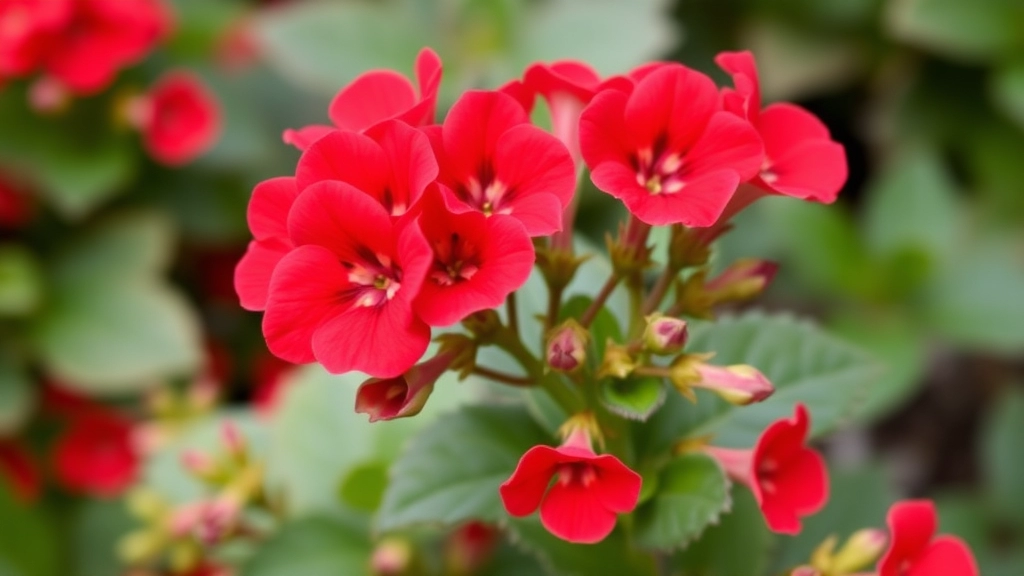Kalanchoe with Red Flowers
When it comes to adding a splash of vibrant colour to your indoor garden, Kalanchoe with red flowers is a top choice. Known for their stunning blooms and easy care, these plants, especially varieties like Kalanchoe blossfeldiana, can brighten up any space. To keep your Kalanchoe flourishing, it’s essential to understand their growing conditions, watering needs, and light requirements.
Caring for Kalanchoe
Caring for Kalanchoe with red flowers is straightforward if you follow a few key tips. Ensure they receive plenty of indirect sunlight and water them sparingly to prevent root rot. Understanding how to encourage re-blooming and manage common pests will also help maintain the vibrancy and longevity of your Kalanchoe’s beautiful red flowers. Whether you’re a seasoned gardener or a beginner, these insights will help you enjoy your Kalanchoe to the fullest.
Best Varieties of Kalanchoe with Red Flowers
When it comes to adding vibrant colour to your indoor garden, Kalanchoe plants are a fantastic choice. But with so many varieties available, which ones truly stand out with their striking red flowers?
Popular Red-Flowering Kalanchoe Varieties
- Kalanchoe Blossfeldiana
This is one of the most popular varieties, known for its clusters of bright red flowers.
It blooms profusely, making it a delightful addition to any space. - Kalanchoe thyrsiflora
Often called the “Flapjack” plant, this variety features stunning red flowers that appear on tall stalks.
Its unique leaf shape adds an interesting visual element to your collection. - Kalanchoe luciae
Known for its rosette shape, this plant showcases red flowers that can create a dramatic contrast against its green leaves.
It’s a hardy variety, perfect for those new to gardening. - Kalanchoe ‘Calandiva’
This hybrid boasts double flowers in a rich red hue.
It’s a compact plant, ideal for smaller spaces. - Kalanchoe ‘Pink Butterflies’
Although primarily pink, this variety can produce red flowers under the right conditions.
It’s known for its unique leaf shape resembling butterflies, adding charm to your collection.
Selecting the right variety of Kalanchoe with red flowers can truly elevate your indoor garden. These plants not only add a pop of colour but are also relatively low-maintenance. For more information on how to care for your Kalanchoe Blossfeldiana, check out our flowering period care tips. Additionally, if you’re interested in learning about the symbolism and meaning of Kalanchoe flowers, we have a detailed guide available.
Ideal Growing Conditions for Kalanchoe
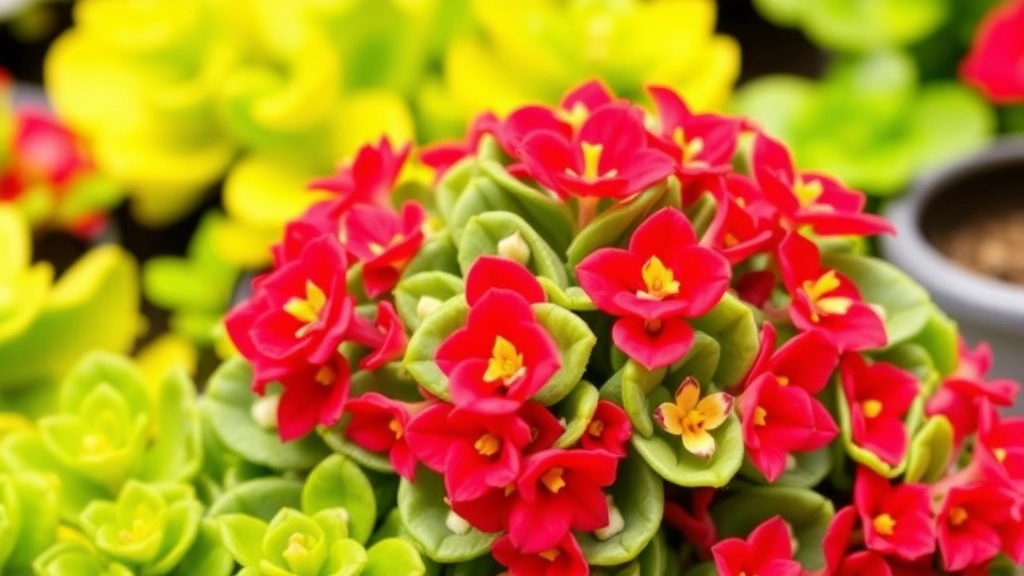
So, you’ve got your eye on that stunning Kalanchoe with its vibrant red flowers, right?
You’re probably wondering, “What does it need to thrive?”
Let’s dive into the ideal growing conditions for Kalanchoe to ensure your plant flourishes.
Light Requirements
Kalanchoe loves the sun, so think bright, indirect light.
- Direct sunlight: A few hours in the morning or late afternoon is perfect.
- Too little light: If your plant starts stretching or losing leaves, it’s craving more light.
Temperature
Kalanchoe is a tropical plant, so it enjoys warmth.
- Ideal range: 18°C to 24°C (65°F to 75°F).
- Avoid cold drafts: Keep it away from chilly windows or air conditioning units.
Humidity Levels
This plant isn’t too fussy about humidity.
- Average indoor humidity: Works just fine.
- Too much humidity: Can lead to rot, so ensure good air circulation.
Potting and Drainage
Proper potting is crucial for Kalanchoe’s health.
- Choose a pot with drainage holes: This helps prevent waterlogging.
- Use a well-draining soil mix: A cactus or succulent mix is ideal.
How to Care for Indoor Kalanchoe Plants
Caring for indoor Kalanchoe plants can seem daunting, especially if you’re new to houseplants. However, with the right approach, you can enjoy their vibrant red flowers and lush foliage.
Understanding Light Requirements
Kalanchoe thrive in bright, indirect sunlight.
- Location: Place your plant near a window that receives ample light but is shielded from harsh midday sun.
- Rotation: Rotate the pot every few weeks to ensure even growth.
Temperature and Humidity
These plants prefer a warm environment.
- Ideal Temperature: Keep temperatures between 18-24°C (65-75°F).
- Humidity: Kalanchoe are adaptable but thrive in moderate humidity. If your home is dry, consider using a humidity tray.
Fertilising for Growth
Feeding your Kalanchoe properly is key to its health.
- Frequency: Use a balanced, water-soluble fertiliser every 4-6 weeks during the growing season.
- Dilution: Always dilute the fertiliser to half strength to avoid burning the roots.
Pruning and Maintenance
Regular maintenance keeps your Kalanchoe looking its best.
- Deadheading: Remove spent flowers to encourage new blooms. For more tips, check out our care tips for thriving Kalanchoe red flower plants.
- Pruning: Trim back leggy growth to promote bushier plants.
Pest Management
Indoor plants can attract pests.
- Common Pests: Watch out for mealybugs and aphids. Learn more about causes and treatments for white spots on Kalanchoe tomentosa.
- Prevention: Regularly inspect your plants and wipe leaves with a damp cloth.
Watering Tips for Healthy Growth
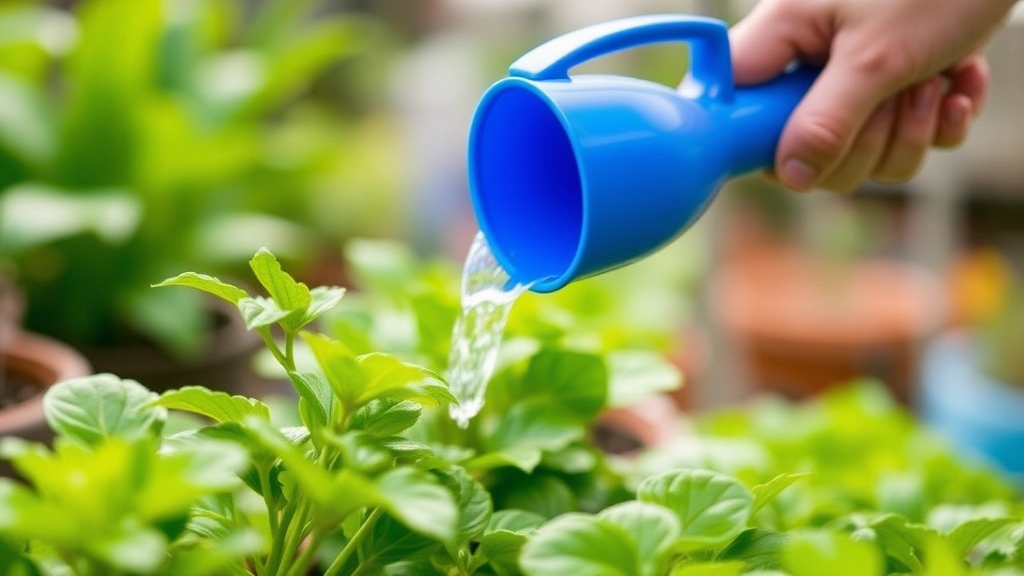
When it comes to nurturing your Kalanchoe, understanding the right watering techniques is crucial for its overall health and vibrancy. Many plant enthusiasts often wonder how frequently they should water their Kalanchoe and what signs to look for to ensure their plants thrive.
Understanding Kalanchoe Watering Needs
Kalanchoe plants are succulents, which means they store water in their leaves and stems. This unique characteristic influences their watering requirements significantly. Here are some essential tips to keep in mind:
- Frequency: Water your Kalanchoe every 2-3 weeks during the growing season (spring and summer). In the dormant months (autumn and winter), reduce watering to once a month.
- Soil Check: Always check the top inch of the soil. If it feels dry, it’s time to water. If it’s still moist, hold off for a few more days.
- Watering Method: Use the soak-and-dry method. Water thoroughly until you see it draining from the bottom, then let the soil dry out completely before the next watering.
- Avoid Overwatering: Kalanchoe is susceptible to root rot. Ensure that the pot has drainage holes and never let the plant sit in standing water.
Signs of Proper Watering
To gauge whether you’re watering correctly, look for these signs:
- Healthy Leaves: Plump, firm leaves indicate adequate hydration. If the leaves are shrivelling or turning yellow, it may be a sign of under or overwatering.
- Flowering: A well-watered Kalanchoe will produce vibrant blooms, particularly during its flowering season.
Encouraging Re-blooming in Kalanchoe
Are you frustrated that your Kalanchoe isn’t blooming again? You’re not alone. Many plant enthusiasts share this concern.
Fortunately, with the right care and attention, you can encourage your Kalanchoe to produce those vibrant red flowers once more.
Common Pests and How to Manage Them
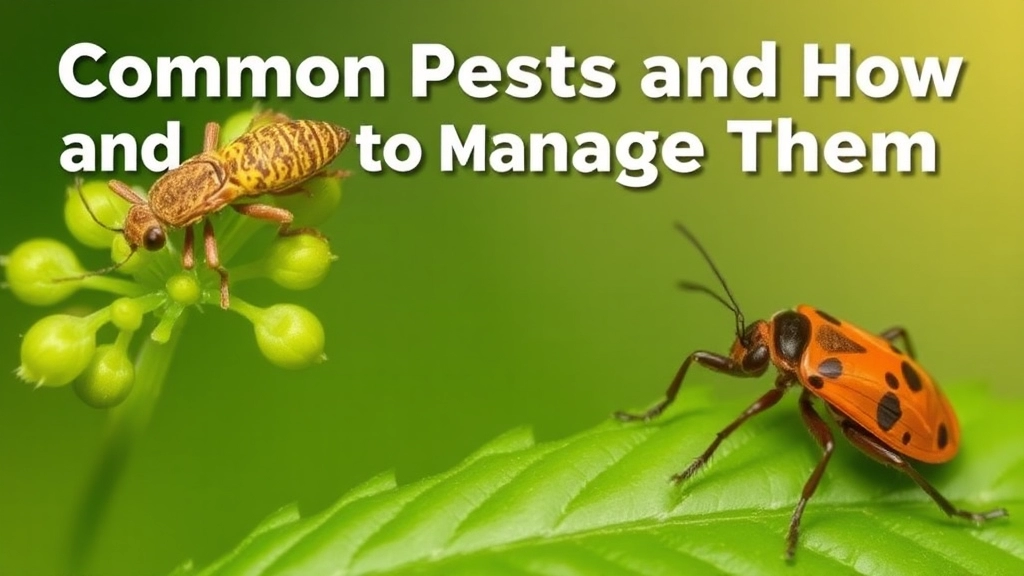
Have you ever noticed little critters on your beloved Kalanchoe? It can be a real bummer when pests invade your plant paradise. But don’t worry; I’ve got your back! Let’s dive into the common pests that can affect your Kalanchoe and how to keep them at bay.
Common Pests
- Aphids
- Tiny, soft-bodied insects that suck the sap from your plants.
- They can cause yellowing leaves and stunted growth.
- Mealybugs
- These little white, cottony blobs love to hide in the leaf joints.
- They can lead to a sticky residue on your plant.
- Spider Mites
- Super small and often go unnoticed until they’ve caused damage.
- Look for fine webbing and speckled leaves.
- Scale Insects
- Hard, shell-like bugs that attach themselves to stems and leaves.
- They can be tough to spot but leave behind a sticky residue.
How to Manage Pests
- Regular Inspections
- Check your Kalanchoe weekly for any signs of pests.
- Early detection can save your plant!
- Natural Remedies
- A mixture of water and dish soap can work wonders.
- Spray it on affected areas and rinse after a few hours.
- Neem Oil
- This natural insecticide is a game changer.
- Just mix it with water and spray it on your plants to deter pests.
- Isolation
- If you spot an infestation, isolate the affected plant immediately.
- This prevents pests from spreading to your other plants.
- Maintain Healthy Plants
- A healthy Kalanchoe is less susceptible to pests.
- Make sure you’re providing the right light, water, and nutrients.
VII. Propagating Kalanchoe Successfully
Are you eager to expand your Kalanchoe collection or share these vibrant plants with friends? Propagation is a rewarding process that allows you to create new plants from existing ones.
Methods of Propagation
Kalanchoe can be propagated in a few simple ways:
- Leaf Cuttings: This is one of the easiest methods. Select a healthy leaf, cut it cleanly, and allow it to dry for a day or two. Then, place it on well-draining soil, ensuring the cut side is in contact with the soil.
- Stem Cuttings: Choose a healthy stem and cut it just below a leaf node. Let it dry for a couple of days to form a callus, then plant it in soil.
- Offsets: Many Kalanchoe varieties produce offsets, or “pups,” at the base. Gently separate these from the parent plant and replant them.
Ideal Conditions for Propagation
For successful propagation, consider these factors:
- Light: Place cuttings in bright, indirect light to encourage growth without burning the leaves.
- Humidity: Maintain moderate humidity around the cuttings, but avoid overly damp conditions that can lead to rot.
- Soil: Use a well-draining potting mix to prevent excess moisture, which can hinder root development.
Monitoring Progress
Keep an eye on your cuttings:
Seasonal Care: Adapting to Indoor and Outdoor Environments
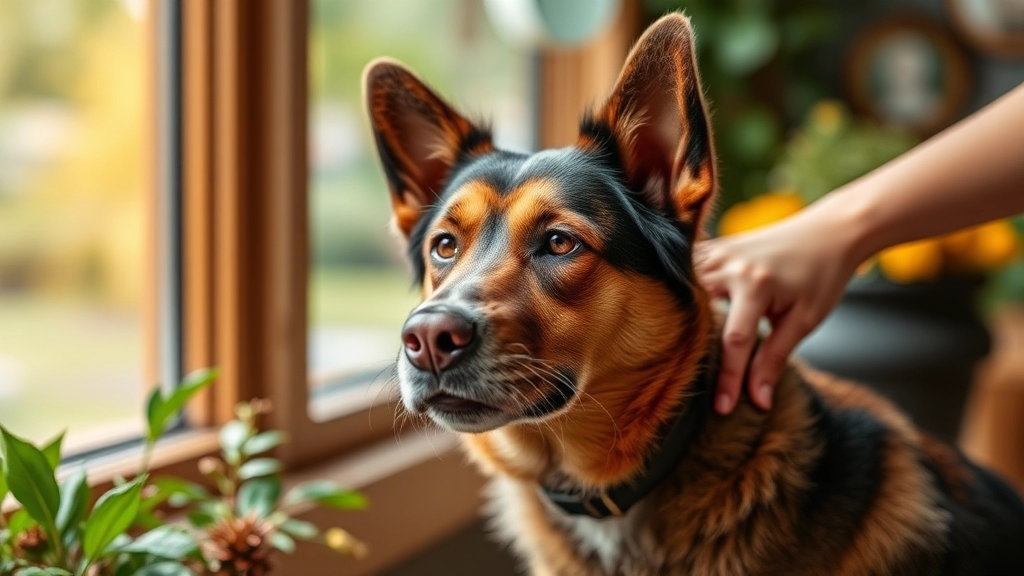
When it comes to caring for Kalanchoe, understanding seasonal changes is key. You might be wondering how to keep your vibrant red flowers thriving, whether they’re inside or outside.
Indoor Care
For indoor Kalanchoe, the changing seasons can really impact their growth. Here’s what to keep in mind:
- Winter: Keep your Kalanchoe in a bright spot, but away from drafts. They love warmth, so aim for temperatures around 15-20°C. Reduce watering since they go dormant.
- Spring: This is when your plant wakes up! Increase watering and consider repotting if it’s outgrown its pot. A little fertiliser can also help kickstart growth.
- Summer: Your Kalanchoe will soak up the sunlight. Ensure it gets around 6 hours of indirect light daily. Keep the soil slightly moist but not soggy.
- Autumn: Gradually reduce watering as the plant prepares for dormancy. It’s also a good time to check for pests, as they can be more active during this transition.
Outdoor Care
If you’re growing Kalanchoe outside, the seasons play a big role too. Here’s how to adapt:
- Spring: Once the frost has passed, you can move your Kalanchoe outside. They thrive in well-draining soil and need plenty of sunlight.
- Summer: Protect from the harsh afternoon sun. A little shade can prevent leaf scorch. Water when the top inch of soil feels dry.
- Autumn: As temperatures drop, bring your Kalanchoe indoors if they can’t handle the chill. Check for any pests that might have hitched a ride.
- Winter: Keep them in a warm, bright spot indoors. They need less water during this time, so let the soil dry out a bit between waterings.
By adjusting your care routine based on the seasons, you’ll help your Kalanchoe thrive, whether it’s indoors or outdoors.
When it comes to nurturing your Kalanchoe, the right soil and fertilizer can make all the difference. Many plant enthusiasts often wonder what specific conditions their Kalanchoe needs to thrive.
### Ideal Soil for Kalanchoe
Kalanchoe plants prefer well-draining soil that allows excess moisture to escape. Here are some key points to consider:
– **Cactus Mix**: A commercial cactus or succulent mix is often ideal. It provides excellent drainage and aeration.
– **DIY Mix**: If you prefer a homemade option, combine potting soil with perlite or coarse sand (50/50 ratio). This enhances drainage and prevents root rot.
– **pH Level**: Aim for a slightly acidic to neutral pH (around 6.0 to 7.0). This helps your Kalanchoe absorb nutrients effectively.
For more detailed guidance, you can refer to our [ultimate guide to growing and caring for succulent plant Kalanchoe](https://planthq.org/ultimate-guide-to-growing-and-caring-for-succulent-plant-kalanchoe/).
### Choosing the Right Fertilizer
Fertilizing your Kalanchoe correctly is crucial for vibrant blooms and healthy growth. Here’s what you should keep in mind:
– **Type of Fertilizer**: Use a balanced, water-soluble fertilizer, such as a 20-20-20 formulation. This ensures your plant receives essential nutrients.
– **Frequency**: Fertilize every 4-6 weeks during the growing season (spring and summer). Cut back on fertilizing in the fall and winter when the plant is dormant.
– **Dilution**: Always dilute the fertilizer to half strength. This prevents over-fertilization, which can harm your plant.
If you notice any issues like yellowing leaves, you might want to check out our [causes and solutions for brown spots on Kalanchoe leaves](https://planthq.org/causes-and-solutions-for-brown-spots-on-kalanchoe-leaves/) to adjust your care routine.
FAQs on Caring for Kalanchoe with Red Flowers
What kind of light does Kalanchoe with red flowers need?
Kalanchoe thrives in bright, indirect light. A few hours of direct sunlight in the morning or late afternoon is ideal. If your plant starts stretching or losing leaves, it needs more light.
What is the ideal temperature range for Kalanchoe?
The ideal temperature range for Kalanchoe is between 18°C to 24°C (65°F to 75°F). Avoid exposing it to cold drafts from windows or air conditioning units.
How often should I water my Kalanchoe?
During the growing season (spring and summer), water your Kalanchoe every 2-3 weeks. In the dormant months (autumn and winter), reduce watering to once a month. Always check the top inch of soil to ensure it’s dry before watering.
What signs indicate proper watering?
Healthy Kalanchoe leaves should be plump and firm. If the leaves are shrivelling or turning yellow, it may be a sign of under or overwatering. Well-watered Kalanchoe also produces vibrant blooms during its flowering season.
What are common pests that affect Kalanchoe, and how can I manage them?
Common pests include aphids, mealybugs, spider mites, and scale insects. Regular inspections, natural remedies like water and dish soap, neem oil, and isolating affected plants can help manage these pests. Maintaining healthy plants also reduces susceptibility to pests.
What are the potting and drainage requirements for Kalanchoe?
Choose a pot with drainage holes to prevent waterlogging and use a well-draining soil mix, such as a cactus or succulent mix.
How should I care for my Kalanchoe indoors during different seasons?
- Winter: Keep in a bright spot away from drafts, with temperatures around 15-20°C. Reduce watering.
- Spring: Increase watering, consider repotting, and use a little fertiliser.
- Summer: Ensure it gets around 6 hours of indirect light daily. Keep the soil slightly moist.
- Autumn: Gradually reduce watering and check for pests.
How should I care for my Kalanchoe outdoors during different seasons?
- Spring: Move outside after the frost has passed. Ensure well-draining soil and plenty of sunlight.
- Summer: Protect from harsh afternoon sun and water when the top inch of soil is dry.
- Autumn: Bring indoors as temperatures drop and check for pests.
- Winter: Keep in a warm, bright spot indoors and reduce watering.
References
-
How to Grow Kalanchoe Indoors
-
Kalanchoe Plant Care â Growing Tips For Kalanchoe
-
Kalanchoe: How to Grow and Care for Kalanchoe Plants
